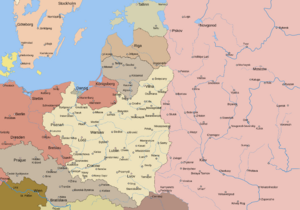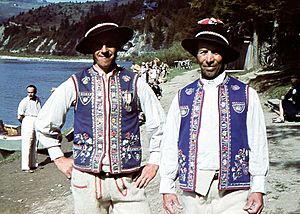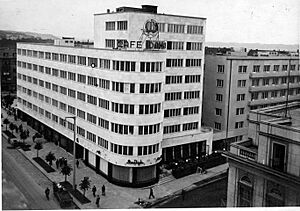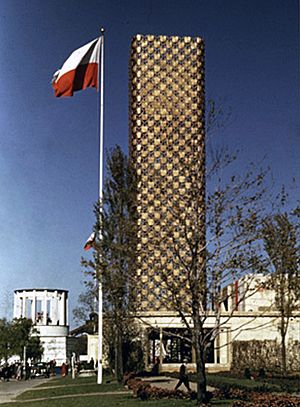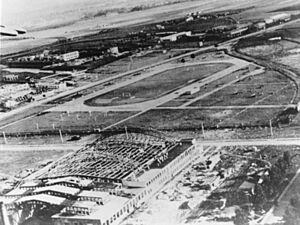History of Poland (1918–1939) facts for kids
The history of Poland between the world wars covers the time from 1918 to 1939. This was when Poland became an independent country again. It lasted until Nazi Germany invaded in 1939, starting World War II. The Soviet Union invaded Poland from the east two weeks later. This period of about 20 years is often called the Interbellum.
Poland had been divided by Austria-Hungary, Germany, and Russia for over 100 years. It finally became free in November 1918. Its independence was officially recognized by the winning countries of World War I in the Treaty of Versailles in June 1919. Poland also gained most of its land through several border wars fought from 1918 to 1921. Poland's borders were finalized in 1922 and recognized by other countries in 1923.
At first, Poland had a democratic government, but it was very disorganized. This changed when Józef Piłsudski took control in May 1926. After that, democracy ended. The country focused on giving land to farmers, and its economy grew a lot between 1921 and 1939. About one-third of Poland's people were minorities. These included Ukrainians, Jews, Belarusians, Lithuanians, and Germans.
Contents
How Poland Became a Country (1918-1921)
Poland's independence was strongly supported by Roman Dmowski and Ignacy Jan Paderewski in Paris. U.S. President Woodrow Wilson made Poland's freedom a key goal in his Fourteen Points. The Allies agreed to this goal in early 1918. As part of the peace terms for Germany, all German troops had to leave Poland.
When the war ended, the Germans sent Piłsudski, who was under arrest, back to Warsaw. On November 11, 1918, he took charge of the government the Germans had set up. Ignacy Daszyński led a short-lived Polish government in Lublin from November 6. But Piłsudski was seen as the most important leader. Daszyński and other Polish leaders accepted him as the head of the army and the new Second Polish Republic. Germany, now defeated, pulled its forces out of Poland. Jędrzej Moraczewski became the first prime minister in November 1918. Dmowski led the largest political party.
From the very beginning, Poland fought several wars to secure its borders. The country was mostly rural and poor. The richest areas were in the western parts, which used to be German. Industry grew very slowly. In the mid-1930s, the government started developing the Central Industrial District to boost industry.
Setting Poland's Borders
Most Polish leaders wanted to create a larger Polish state. One idea was to include East Prussia and have the German city of Königsberg join a customs union with Poland. However, they did not want to restore the exact borders of the old Polish–Lithuanian Commonwealth. Much of that land had been controlled by Russia. People there were trying to create their own countries, like Ukraine and Belarus.
Polish politicians had different ideas about how much land the new Polish state should have. Józef Piłsudski wanted a democratic federation of independent states led by Poland. This idea was called "Intermarium". Roman Dmowski, leader of the Endecja movement, wanted a smaller Poland. He believed it should be made up mostly of ethnic Polish areas.
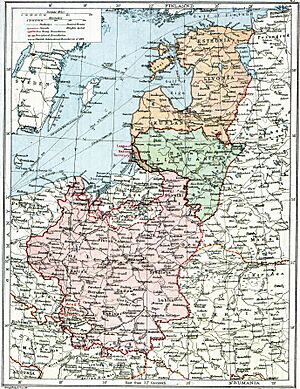
To the southwest, Poland and Czechoslovakia had disputes over their border. Germany was also unhappy about losing land to its new eastern neighbor. The Great Poland Uprising on December 27, 1918, helped free Greater Poland. The 1919 Treaty of Versailles set the German-Polish borders in the Baltic region. The port city of Danzig (Polish: Gdańsk) had many German people and some Poles. It was made a free city, independent of Germany. This caused problems for decades.
The Allies also divided the industrial area of Upper Silesia between Germany and Poland. Poland received the smaller but more industrial eastern part in 1922. This happened after three Silesian Uprisings.
War with Soviet Russia
The war with the Soviets was the most important event that shaped Poland's eastern borders. This area was very chaotic due to the Russian Revolution of 1917 and the Russian Civil War. Piłsudski wanted to create a federation with Ukraine and Lithuania. This would form a large Central and East European federation called "Intermarium".
Lenin, the leader of Russia's new communist government, saw Poland as a path for communism to spread into Germany. The situation was also complex because some disputed regions had changed identities since the partitions. Some did not even have a Polish majority. Yet, Poles still saw them as historic Polish lands. In the end, talks failed, and Piłsudski's federation idea did not happen. Instead, wars like the Polish-Lithuanian War and the Polish-Ukrainian War decided the borders.
The Polish-Soviet war began in 1919. Piłsudski launched a major attack into Ukraine in 1920. Polish-Ukrainian forces reached Kiev in May. However, a few weeks later, the Soviet army counter-attacked. Polish forces were forced to retreat back into Poland. Many people thought Poland would be defeated.
But at the Battle of Warsaw, Piłsudski organized a surprising counter-attack. This led to a famous victory. This "Miracle on the Vistula" became a very important moment in Polish history. Piłsudski continued the attack, pushing the Soviet forces east. Finally, both sides were tired. They signed a peace treaty at Riga in early 1921. This treaty divided the disputed lands of Belarus and Ukraine between them.
These new lands were recognized by international agreements. The treaty gave Poland an eastern border much further east than what the peacemakers in Paris had planned. It added 4 million Ukrainians, 2 million Jews, and 1 million Belarusians to Poland's population.
In 1922, after the Polish-Soviet War, Poland also officially took over Central Lithuania. This happened after a vote, but Lithuania never recognized it.
The Riga agreement affected the entire region for years. Ukrainians and Belarusians found themselves without their own country. Some Polish speakers also ended up inside the Soviet Union. These Poles faced forced collectivization, state terror, and purges. The new Second Polish Republic had many non-Polish citizens. It focused on promoting Polish identity and language. This made ethnic minorities feel left out.
From Democracy to Strongman Rule
Reborn Poland faced many big challenges. There was widespread war damage and a struggling economy. One-third of the people were wary national minorities. The economy was largely controlled by German businesses. Poland also needed to bring together the three parts that had been separated for over a century.
Poland's official political life began in 1921. A new constitution was adopted. It made Poland a republic, similar to France. Most power was given to the parliament, called the Sejm. This was mainly to stop Piłsudski from becoming a dictator. Many political parties appeared, with four major ones and dozens of smaller ones. They had very different ideas and often disagreed.
The new government was inexperienced and faced serious problems. There was a lot of corruption among officials. Governments changed very often, causing confusion and distrust. There was also deep disagreement about including minorities in the new state. Roman Dmowski wanted a Poland made up of only ethnic Poles. He was anti-German and believed Poland should be Catholic.
Piłsudski, however, believed in a multi-ethnic Poland, like the old Polish–Lithuanian Commonwealth. This meant he often ignored minority votes at home. All adult citizens could vote, which gave minorities a voice. They formed a group called the Bloc of National Minorities (BMN). This group included Jews and others, making up one-third of the population. However, voting districts were designed to reduce minority representation. The BMN helped elect Gabriel Narutowicz as president in 1922. But he faced harsh attacks from the right and was assassinated after only five days in office. The BMN group became less important and closed down in 1930.
The 1926 Coup
After the constitution was adopted, Piłsudski resigned from office. He was unhappy with the limited power of the executive branch. But he kept a close watch on politics. The parliament (Sejm) was not very effective. Some of Piłsudski's friends suggested he take power by force. He refused at first.
By 1926, he was convinced. He launched the May Coup in 1926, which succeeded with little violence. For the next ten years, Piłsudski was the strongman of Poland. His government was generally popular. He never held a formal title except for minister of defense. He kept the 1921 constitution, and the Sejm continued to operate. But it almost always did what he wanted. Critics of the government were sometimes arrested, but most were sued for libel. Piłsudski presented himself as a national hero, above political parties. He gained more support by distancing himself from the Polish Socialist Party.
In 1935, a new Polish Constitution was adopted. But Piłsudski died soon after. His successors moved towards a more authoritarian government. People who spoke out against the government were increasingly bothered or jailed. This was not surprising, as the government worried more and more about national security.
In many ways, the Second Republic did not meet the high hopes of 1918. Like in other parts of Central Europe, except for Czechoslovakia, the attempt to create a democracy did not fully succeed. Governments were divided between right-wing and left-wing groups. Neither side was willing to accept the actions of the other.
Economic and Social Challenges
Poland faced big problems with foreign-owned businesses and its many minority groups.
The government took over foreign-owned businesses. This was because there wasn't enough Polish money to buy them. It was also easier than deciding who should get what. Poland had more government control over its economy and less foreign investment than other Eastern European countries. This focus on central control slowed Poland's development.
The economy was mostly based on farming. The worldwide Great Depression began in 1929. This caused hardship everywhere. Farmers were hit the hardest, with their incomes dropping by half or more. The government had few solutions, mostly cutting its own spending as tax money decreased.
Minority Groups
About one-third of Poland's people belonged to minority groups. These included five or six million Ukrainians, over three million Jews, one and a half million Belarusians, and about 800,000 Germans. These minorities felt increasingly left out. They complained that they were ignored in politics and denied rights Poland had agreed to in treaties.
As the Great Depression worsened in the 1930s, discrimination against Jews increased. Poland was home to over three million Jews, which was 10 percent of its population. This was the largest Jewish population in Europe at the time. Poor Jewish families relied on their own local charities. By 1929, these charities were providing services worth 200 million zlotys a year. This was partly because working Jews earned about 40% more than non-Jewish Poles.
From the 1920s, the Polish government made it harder for Jews to get government bank loans, public sector jobs, and business licenses. In the 1930s, limits were placed on Jewish enrollment in universities. There were also restrictions on Jewish shops, export firms, and their entry into medical and legal professions. In 1937, a political party called the Endeks stated that their main goal was "to remove the Jews from all parts of social, economic, and cultural life in Poland."
In response, the government organized the Camp of National Unity (OZON). OZON supported the idea of many Jews leaving Poland. They also promoted boycotts of Jewish businesses and other limits on Jewish rights. On the international stage, Poland supported creating a Jewish state in Palestine. They hoped that gradual emigration over 30 years would reduce the Jewish population in Poland to 500,000. Poland even worked with Ze'ev Jabotinsky, a leader of Revisionist Zionism. He hoped Poland would take over the mandate of Palestine from Great Britain. His "Evacuation Plan" called for 1.5 million Jews to settle in Palestine within 10 years, including 750,000 Polish Jews. The Polish government liked this idea, as it wanted its Jewish population to emigrate.
Farming and Land Reform
Seven out of ten people in Poland worked on farms. Polish agriculture faced common problems for Eastern European countries. These included old technology, low production, and a lack of money and access to markets. The former German areas in the west had better soil and rain, making them the most productive. The former Russian and Austrian areas were below average.
Polish farmers believed it would be much better if they owned their land and did not pay rent to landowners. They supported agrarianism, which called for land to be taken from large estates and given to peasants. This was done, and many very small farms were combined into larger, more workable units. Land reforms were also carried out based on ethnic groups. In the west, Germans who became foreigners in 1919 quickly lost their land. In the east, however, Ukrainian and Belarusian peasants worked for Polish landowners. No serious steps were taken to redistribute land there. Few other jobs were created, so many people in rural areas were underemployed.
The socialist politician Bolesław Limanowski thought deeply about agrarianism. He created a unique plan that fit Poland's situation. His experience as a farm manager, combined with socialist ideas, shaped his views. He suggested a type of agrarian socialism with large state farms. This would help make up for the inefficiency of very small farms. In independent Poland, he supported taking land from wealthy landowners. He also believed that Poland should combine voluntary cooperation with individual ownership of leased land. His practical approach even allowed for private peasant ownership, despite his Marxist beliefs.
Poland's Place in the World
Józef Beck was the foreign minister and fully in charge of foreign policy by 1935. But he was in a difficult position. Poland had 35 million people, but its industry was not strong. Its war plans focused on the Soviet Union, not Germany. Poland shared long borders with two powerful dictatorships: Hitler's Germany and Stalin's USSR. Poland became more and more isolated.
In February 1921, Poland signed a secret military agreement with France. This meant they would help each other if Germany attacked. In March 1921, Poland signed a mutual assistance treaty with Romania. This was aimed at the threat from the Soviet Union.
Poland wanted to lead a group of independent nations between the Soviet Union and Germany. This group would unite to defend against these powers. However, Poland had so many disputes with its smaller neighbors that it could never form such a group. At first, France supported Poland. France wanted an ally against Germany. If Germany faced a war on two fronts, it would be less likely to attack France. France was especially helpful at the 1919 Paris conference and in the 1920s. It resisted British efforts to weaken Poland. After 1935, however, France did not trust Beck and lost interest in Eastern Europe. Poland became increasingly alone.
In 1925, Germany officially recognized its western borders with France. But it did not recognize its eastern borders with Poland. The same year, Germany cut its coal imports from Poland by half. This started the German–Polish trade war. Relations with the Soviet Union remained unfriendly. But Piłsudski was willing to talk, and in 1932, the two countries signed a non-aggression pact.
Soon after, Hitler came to power in Germany. Some rumors said that Piłsudski suggested to France that Poland and France should attack Hitler in 1933. Most historians do not believe this happened. Piłsudski's war plans focused on Russia, and he made no preparations for war with Germany. Also, no one in France reported such an inquiry from Poland. Piłsudski made demands about Danzig, which Hitler immediately approved. Relations between Poland and Nazi Germany became friendly. They signed the German–Polish Non-Aggression Pact in January 1934.
At the same time, Czechoslovakia, Romania, and Yugoslavia were allied in the Little Entente with French support. If Poland joined, it could have had more security. However, relations with Czechoslovakia were unfriendly due to border disputes. So, they never reached an agreement.
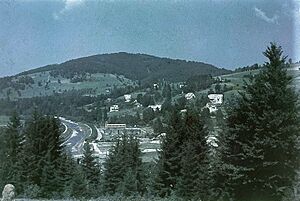
France was an ally of both Poland and Czechoslovakia. It tried many times to get them to solve their border disputes and become allies. France also wanted them to work with the Soviet Union. This did not happen. Not only because of border issues, but also because Czechoslovakia was willing to work with Moscow, while Poland wanted to stay far away from Moscow. Czechoslovakian President Edvard Beneš warned that strong ties with Poland could be dangerous for Czechoslovakia. He rejected Beck's idea to work together against Germany.
The failure to form any alliances in Eastern Europe meant Poland's only ally was France. Piłsudski increasingly doubted how useful that alliance was. The Locarno Pact, signed in 1925 by major West European powers, aimed to guarantee peace. But it did not guarantee Poland's western border.
In May 1934, the Polish-Soviet non-aggression pact was extended until December 31, 1945. During 1934–1939, Polish-Soviet relations were "correct but cool." Polish-German relations were "normal and sometimes friendly."
Military Strength
In 1934-35, the army budget was 762 million zlotych, about 32% of the total budget. It provided for 7,905 officers, 37,000 professional soldiers, and 211,110 militia soldiers. Besides the army, the budget also gave 105 million zlotych for police troops. These consisted of 774 officers and 28,592 men.
By 1939, Poland had a large army. There were 283,000 soldiers on active duty. They were organized into 37 infantry divisions, 11 cavalry brigades, and two armored brigades, plus artillery units. Another 700,000 men were in the reserves. A big problem was a lack of money. The limited defense budget allowed for very little modernization. Most weapons were made in Poland, but production was slow. Also, foreign money was scarce.
Poland was only halfway through its rearming process, which was supposed to finish in 1942. Ten divisions were never called up. The cancellation of mobilization, due to pressure from France and Great Britain, and then restarting it less than a week later, caused confusion. Also, German military and civilian groups spread rumors of ethnic cleansing. This made thousands of people flee the German advance, making military movements difficult.
Poland had PZL, a state aviation company that made good planes. In 1931, it developed the PZL P.11, which was the most advanced fighter plane in the world in the early 1930s. In the mid-1930s, its successor, the P-24, was even better. But Poland exported it to earn money. This forced them to use older PZL P.11 and PZL P.7 fighters. These were no match for the German Messerschmitt 109, which was faster and better armed. Despite the weaknesses, the P.11 was credited with at least 110 victories for the loss of about 30 of its own. The PZL.37 Łoś was an excellent twin-engine bomber. Poland had 36 ready for combat when the war started. In 1939, Poland had 390 combat planes, most of which were outdated. Germany had 2800 new fighter planes, plus bombers and transport planes.
Despite their difficult situation, the Poles managed to win two battles against the invading Soviets. In one battle, Soviet infantry charged Polish positions shoulder to shoulder, making them easy targets for machine guns. Some Soviet prisoners of war even switched sides to the Polish army.
Poles also broke an early diplomatic version of the Enigma cipher. They shared their findings with France and the United Kingdom.
Despite its weaknesses, the Polish military was among the top 10 strongest national militaries in 1939. This was not because the Polish military was so great, but because other national armies were very weak. Experts like Zaloga and Madej point out that Poland had one of the largest tank forces in the world in 1939, even bigger than the US tank force.
The strength of the Polish armed forces was shown by Lithuania's acceptance of the 1938 Polish ultimatum to Lithuania. Poland's military power made the government's claims believable to the public. The Polish government had to claim that any attack by Germans or Soviets would be stopped. The government could not afford for the public to lose hope. This was especially true because of industrial projects like the Central Industrial Region (Poland), which were almost finished by early 1939.
Foreign Policy (1935–1939)
After Piłsudski's death in May 1935, policies in Poland were set by five senior officials. These included President Ignacy Mościcki, Vice-President Eugeniusz Kwiatkowski, Premier Felicjan Sławoj Składkowski, and Marshal Edward Smigly-Rydz, the army's Commander-in-Chief. Foreign policy was solely handled by Foreign Minister, Colonel Józef Beck. Elections were held, but there was no real democracy, and the parliament (Sejm) simply approved what the leaders wanted.
Poland's dream of leading a group of neutral nations in Eastern Europe ended after 1933. This was due to Hitler's openly expansionist Nazi government in Germany. It was also clear that France did not want to resist Germany's expansion. Piłsudski kept the alliance with France but trusted it less and less. Hitler's long-term goals included taking over Polish territories. He also wanted to control the remaining parts of Poland. He revealed this idea to his closest friends as early as 1933.
Poland's solution was to have normal relations with both Germany and the Soviet Union, but not to ally with either. This was called "the policy of equal distance." So, Polish leaders rejected German offers to work together against Russia. At the same time, Beck wanted to prevent Poland from getting into a conflict with Germany alone. This policy was based on non-aggression pacts Poland signed with Germany and the USSR.
After a border incident in March 1938, Poland sent an ultimatum to Lithuania. It demanded that diplomatic relations be re-established and the previously closed border with Poland be reopened. Faced with the threat of war, the Lithuanian government accepted Poland's demands.
In October 1938, the Munich Agreement allowed Germany to take over parts of Czechoslovakia. These areas had many German people and were called the Sudetenland. Britain and France approved this. Poland had long been unfriendly towards Czechoslovakia and now sided with Germany. Poland demanded that Czechoslovakia give up the Teschen region, where about 70% of people were Poles. Otherwise, Poland threatened to take it by force. Facing ultimatums from both Poland and Germany, Czechoslovakia gave up the area. Poland annexed it on October 2, 1938.
In early 1939, Germany invaded the rest of Czechoslovakia. Czechoslovakia then ceased to exist in March 1939. Germany demanded that Poland join the Anti-Comintern Pact as a satellite state. Germany also demanded a special highway connecting Germany with Danzig and East Prussia. This highway would cut Poland off from the sea and its main trade route. Poland refused. Germany also pushed for Danzig to become part of Germany. Danzig was a Nazi-ruled city-state with a 90% German population. It had been separated from Germany in 1920 and was a Free City in a customs union with Poland.
After Poland rejected German demands about Danzig and Gdańsk Pomerania, its position weakened. Other nations like Hungary and Romania moved closer to Germany. Poland was allied with Romania and France at the time.
Two important events surprised Poland. In late March 1939, Britain and France announced that if Germany invaded Poland, they would declare war. Everyone knew they could do little to help Poland in an actual war. The hope was that the threat of a two-front war would stop Germany. Hitler thought Britain and France were bluffing. But he dealt with the Soviet problem in late August. He made a surprising agreement with Stalin, which was like a friendly alliance. This agreement secretly planned to divide Poland and much of Eastern Europe. The British and French offer was not a bluff. They declared war on Germany when it invaded Poland. But neither was able to provide serious help. Poland itself had a million-man army, but it lacked training, airpower, artillery, tanks, and radios. Poland's military budget was about 2% of Germany's. Its commanding general, Marshal Smigly-Rydz, was not well prepared for the challenge.
The Polish Corridor and Danzig
The Germans wanted to restore the borders from before the Treaty of Versailles. So, they made new demands on Poland. They insisted on a vote to decide who owned the "Polish corridor". Only those living in the corridor before 1918 would be allowed to vote. The plan also called for a population exchange. All Germans in Poland would move out of the final region declared "Poland." The same would happen for all Poles living in what was declared "Germany."
Danzig was to become part of Germany regardless of the vote. But if Germany lost the vote, it would still have access to East Prussia through a highway system it would control. If Poland lost the vote, the corridor would go to Germany. The seaport of Gdynia would become a Polish exclave, with a route connecting Poland to Gdynia. After Britain and France guaranteed support for Poland on April 3, talks about Danzig ended. Germany invaded Poland on September 1, 1939.
The issue of Danzig was not the real reason for the German invasion. Hitler told his generals in May 1939: "It is not Danzig that is at stake. For us, it is a matter of expanding our living space in the east and making food supplies secure." Hitler's main goal was the complete destruction of the Polish state, Polish culture, and the Polish people. He wanted the farmland to resettle German farmers.
See also
- 1934 flood in Poland
- Independent Operational Group Silesia
- Prometheism
- Provisional Polish Revolutionary Committee


